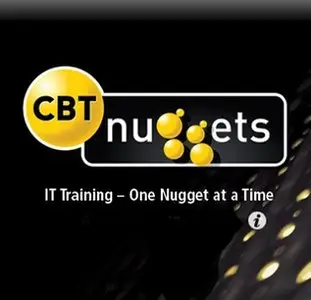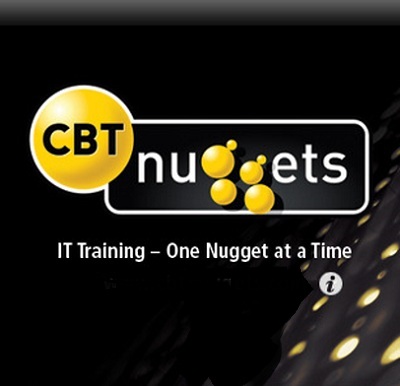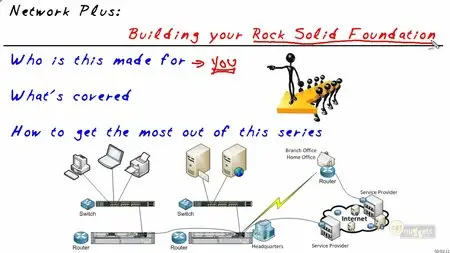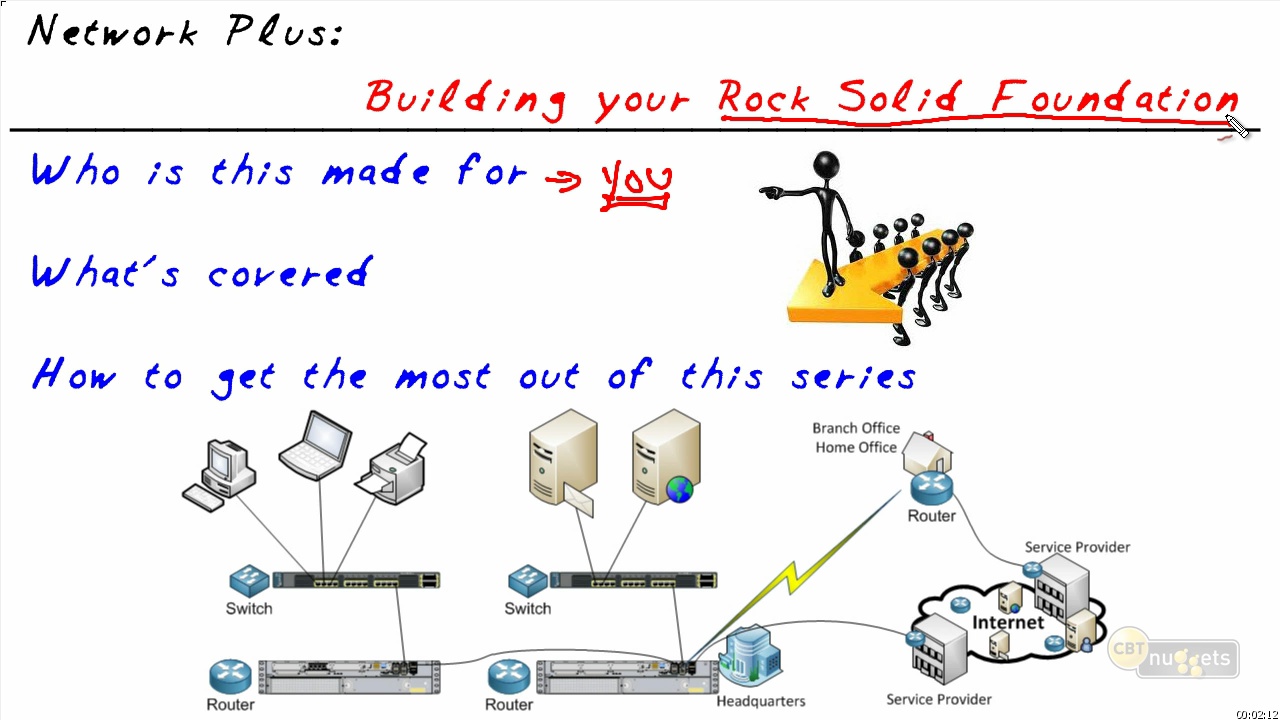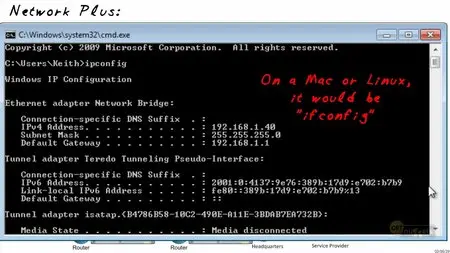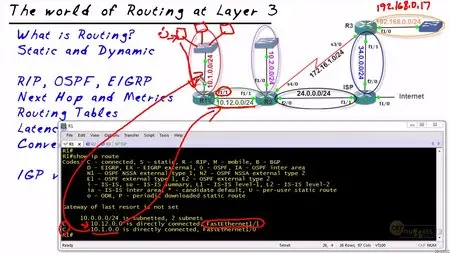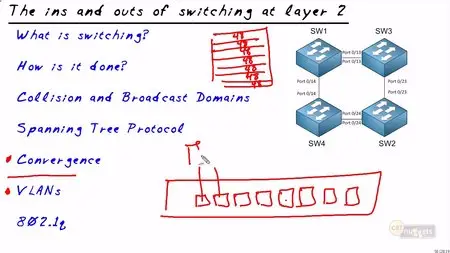CompTIA Network+ N10-005
English | 2012 | flv | 1280x720 | 24 hours | 5.77 GB
English | 2012 | flv | 1280x720 | 24 hours | 5.77 GB
This training series with Keith Barker walks you through CompTIA Network+, and all the 2011 exam objectives for the N10-005 exam. You'll learn how to maintain, secure, troubleshoot, install, control and configure basic network infrastructure. This series offers the perfect way to kick off your network admin career or improve on the networking skills you already have. It's also a terrific introduction to computer networking for business professionals of any stripe.
This exciting series begins by providing you a solid foundation of how computer networks operate, and builds upon that knowledge with real-world examples of network technologies and protocols including the OSI model, TCP/IP, DNS, ARP, IP addressing (including sub-netting), and media types and connectors including fiber optics, copper and wireless.
Keith uses real-world experience and analogies to explain complex topics in simple, easy-to-digest, bite-sized chunks, and makes it fun. In addition to live demonstrations as examples of the technologies taught in the videos, Keith includes protocol analyses (where Keith uses a protocol analyzer to show the details of what is really happening on the network) to reinforce the concepts and ideas learned in the videos. The new Network+ video series covers each and every topic in the latest blueprint for the N10-005 exam, and each Nugget maps to a specific exam objective.
Content:
Introduction to CompTIA Network+ N10-005 - 00:14:13
In this introductory Nugget, Keith Barker discusses what will be covered in this Nugget training series and how the training maps to the N10-005 exam objectives. Keith also gives some advice about on how to get the most out of this training series.
Network Concepts 101: OSI vs TCP/IP - 01:13:12
In this Nugget, Keith explains how computer networks operate, by using interesting analogies, real world examples and presenting it in a fun and easy to understand manner. In this Nugget you will learn how to describe the "thought process" a computer goes through when preparing to send a message, as well as the steps taken by the computer or server who is receiving the message. This Nugget is the foundation for all of the others. Maps to exam objective 1.1
Network Concepts: Matching up Network Components with Their Correct OSI - 00:47:18
Understanding how the real network components we use today, such as network interface cards, addresses, switches and routers, all relate to the OSI model covered in this Nugget. Maps to exam objective 1.2.
NC: IP Addressing Uncut and Uncensored - 01:45:34
IP addresses are something that we work with every day on the network, both IP version 4 and 6. In this Nugget, Keith answers the question "Why do we need IP addresses?", and then proceeds to take you on the journey behind the scenes as the world of IP addressing is demystified, one step at a time. Maps to exam objective 1.3
NC: Routing and Switching - 01:45:06
Learning what to do, and then doing it, are two of the primary responsibilities of routers and switches. In this Nugget, Keith provides examples of what each do, and gives live demonstrations of the most relevant protocols, including RIP, OSPF and EIGRP for routers, and Spanning Tree Protocol (STP) for switches. Maps to exam objective 1.4
NC: Well-Known Ports - 00:34:35
For each popular application layer protocol, (such as HTTP for surfing the Web, DNS to find out what IP address we can use to reach Google.com, and SMTP for sending email), there is a "Well-Known Port" that is associated with each of these protocols. In this Nugget, Keith discusses the reason for these ports, demonstrates them in action and takes you behind the scenes with a protocol analyzer to reinforce what you have learned. Maps to exam objective 1.5
NC: The Functions of Common Protocols - 00:55:17
So what does ARP do, and how does my computer know which IP address it should send a packet to when accessing a Google server? These are just a few of the questions that are answered in this Nugget as Keith reviews several of the protocols in the TCP/IP protocol suite, and introduces you to a few new ones as well. To complete this fun Nugget, Keith provides a demonstration of a computer that joins the network and accesses a Web server, and then we go behind the scenes with a protocol analyzer to confirm the details of how DHCP, ARP, DNS and HTTP were all functioning to make the Web request possible. Maps to exam objective 1.6
NC: Digging into the Details of DNS - 00:32:06
How do we find the phone number of a friend? Usually we will look at some type of online database or phone book, that can provide the phone number based on their name. How does a computer find the IP address of a Web server? As we learned in a previous Nugget, the computer will use the Domain Name System (DNS). On the surface, it looks fairly simple: The computer asks a DNS server, and the DNS server replies, but behind the scenes, there are thousands of servers cooperating together to make this all possible. In this Nugget, Keith provides a sneak peak behind the scenes a the inner workings of the Domain Name System, as well as some tools you can use to verify and troubleshoot DNS. Maps to exam objective 1.7
NC: Using a Method When Troubleshooting - 00:32:59
When the network goes "bump" in the night, and users have lost access, it can be a stressful time for both the users and you, the network technician. By having a method to follow when troubleshooting can give you the edge (and confidence) to ask the right questions, isolate the problem, and get the network up and running. In this Nugget, Keith walks you through using a methodology to do live troubleshooting on network that has been used in class since the first Nugget of this series. Maps to exam objective 1.8
NC: Moving to Virtual - 00:32:00
The world is a changing place, and when a new idea comes along that makes sense, and saves money, it usually moves forward. This is the case with virtualization. In the old days, when a company needed a new server, they would buy one physical sever, install the software, and add it to the network. This process usually took weeks. Now, new servers can be brought online in a "virtual" environment, and be up and running in only minutes. In this Nugget, Keith describes the concepts of how virtualization is possible, then he takes you behind the scenes of how it is done with live examples of virtualized Servers, workstations, routers and switches. Maps to exam objective 1.9
Network Installation and Configuration: Routers and Switches Part 1 of 2 - 00:42:26
Leveraging the fundamentals we learned in the previous Nuggets, it's time to put network pieces together for a functional network. In this Nugget (part 1 of 2), Keith walks you through the configuration of a router including interfaces, routing, access-lists and more. You will also discover the how and why Quality of Service (QoS), Network Address Translation (NAT) and its little friend PAT which are used on today's networks. Maps to exam objective 2.1
NIC: Routers and Switches Part 2 of 2 - 00:42:15
Implementing switching, correctly, is a key skill for a network technician. In this Nugget, Keith reviews the concepts of VLANs, and dives in deeper to discuss the details implementing them, as well as trunking (802.1q) and VLAN Trunk Protocol (VTP). Join Keith as he discusses Power over Ethernet (PoE), port mirroring and much more. Maps to exam objective 2.1
NIC: The World of Wireless - 00:46:23
Wireless networking has become an expected feature in business, at hotels, coffee shops and many homes. As network technicians, we must understand the details of the protocols (the rules) and standards for WiFi to successfully implement a wireless network. In part one of this two-part Nugget, Keith walks you through the standards used in wireless, explains the components and how they inter-operate together. Maps to exam objective 2.2
NIC: Configuring the Wireless Network - 00:32:31
In this Nugget, Keith has you join him as he does a "site survey" of existing wireless networks (in real time) to discover the appropriate channel to use for a new wireless transmitter. Armed with that information, you will then join Keith as he walks you through the configuration of a wireless router, and then verifies the configuration by having a wireless client connect to the network. Maps to exam objective 2.2
NIC: Going Deeper into DHCP - 00:22:08
DHCP is a fantastic protocol to dynamically assign IP addresses to network devices. DHCP was introduced in an earlier Nugget, and in this Nugget Keith takes you on a deeper discussion of the protocol, including how it is implemented in a larger corporate network scenario. Maps to exam objective 2.3
NIC: Troubleshooting Wireless Networks - 00:25:07
Using the airwaves to transmit bits is way cool, but unfortunately, there are several factors that can prevent the wireless network for operating at its best. In this Nugget, Keith shares with you some common challenges that arise in wireless networks, and how to identify and resolve them. Maps to exam objective 2.4
NIC: Troubleshooting common Router and Switch problems - 00:54:54
"The network is down!" (A quote from an average user)
Users really only want 2 things: 1) The network to work, and 2) The network to be fast. If either of these aren't the case, they will let you know (and they outnumber us). In times like these, we need to have troubleshooting skills that can confirm a problem, and then like a detective, narrow down the possible causes until we find and correct the problem. In this Nugget, Keith takes you on a journey through a laundry list of things that could go wrong as you and he troubleshoot a live network using both end station troubleshooting tools, (like nslookup) and network tools such as the CLI on a router. Maps to exam objective 2.5
NIC: Plan and Implement a Small Network - 00:21:01
Ever have that moment, when they turn to you and ask you to design and implement a network? Now is your chance to do it, alongside Keith, as you both gather requirements from a customer, design the network and identify how all the pieces correctly function together. Maps to exam objective 2.6
Media and Topologies: Fiber and Copper Media - 00:41:39
If layer 1 isn't happy, layer 2 isn't happy. (Paraphrased and adapted quote from my father. I think the actual quote was "If mom isn't happy, ain't nobody happy.")
MT: Connector Types - 00:30:06
Having the correct media in place is important, but unless that media is correctly connected to the network devices (hosts, routers, switches, etc.) the media won't be of much use. In this video, Keith describes the cable connectors, both fiber and copper types that are commonly used today, and provides some fun ways to remember their names. Maps to exam objective 3.2
MT: Wireless Standards - 00:24:11
In a previous Nugget, we learned about the 802.11 wireless standards. In this video Keith reviews wireless standards and takes you even deeper into their characteristics, because of the importance that wireless has in our high speed networks today. Maps to exam objective 3.3
MT: WAN Technologies - 00:52:23
Any way you slice it, Wide Area Networks (WANs) are going to require the use of a 3rd party, the service provider. The lightning bolt that represents the WAN can be implemented in many different ways, using a variety of technologies. In this video, Keith demystifies the terms of T1, T3, OC3, etc. and discusses the options regarding WAN services that can be obtained from a provider. Maps to exam objective 3.4
MT: LAN and WAN Topologies - 00:31:09
How can a network be a logical bus and a physical star (at the same time) and what is a logical bus anyway? Those are great questions which will be addressed in this video about network topologies. This Nugget includes a brief history lesson regarding the beginnings of Ethernet, and then dives into LAN and WAN topologies that are in use in our production networks today. Maps to objective 3.5
MT: Common Physical Layer Problems - 00:30:16
The cabling for the network is like the arteries and veins in the human body. If they stop allowing data to flow through the network, clients and servers won't be able to communicate, which translates to loss of productivity and loss of revenue. In this video Keith talks with you about several of the very common mistakes and issues that arise with physical cabling, as well as some tips to avoid those problems. Maps to objective 3.6
MT: Comparing LAN technologies - 00:34:30
Acronyms are in heavy use on the network, and the terms used for cabling are no exception. This video will demystify the terms used for many of the common cable types, as well as compare the throughput and distances supported by them. In this video, Keith reinforces your foundation of how the network operates, and then adds to that some new content including an explanation and demonstration of bonding 2 or more Ethernet connections together to create a single larger Ether-channel. Maps to objective 3.7
MT: Describing the Cable Plant - 00:19:08
This plant requires no water to grow. :) By being organized, with a plan and structure for our cables, racks, routers, etc., we can expand our network and keep our sanity at the same time. In this video, Keith explains and discusses wiring distribution terms such as IDF, MDF, Demarcation Point, and many more. This is an important Nugget, as you are likely to hear these terms on a regular basis when working on a corporate network. Maps to objective 3.8
NM: Network Appliances - 00:22:02
A Network Appliance is a dedicated box (a server) that performs a specific function in the network. In this video, Keith provides examples of how a network appliance can be used to address a need on a network. Load balancing, VPN Concentrators, Proxy Servers, Firewalls and more are explained in this video. Maps to objective 4.1
NM: Hardware Tools for Troubleshooting - 00:30:41
Cables look so innocent from the outside, but can have all sorts of problems on the inside, such as open connections, shorts, incorrect pairs, etc. In this video, Keith takes you on a journey through the world of specialized hardware tools: Cable Testers, Toner Probes, TDR/OTDRs and many others, to discuss with you how and when those tools can be used to troubleshoot physical cabling issues. Maps to objective 4.2
NM: Software Tools for Troubleshooting - 00:39:26
Sometimes, the correct tool to verify IP connectivity or DNS functionality, is right in front of us, as a program that is pre-installed on a workstation. In this Video, we will re-visit some of our old friends: Tracert, Nslookup, Ping and IPconfig. Keith will also introduce and demo some new software utilities including DIG, Netstat, remote control software and more. Maps to objective 4.3
NM: Analyze Network Traffic - 00:33:35
How do you know? Specifically, how do we find out what is really happening on our networks? The answer is simple if we know where to look. In this video, Keith explains where to look and demonstrates how to discover what is happening on the network. Tools discussed in this video include SNMP, Syslog, Protocol Analyzers and more in the pursuit of discovering the details about the traffic that is coursing through the veins of our networks. Maps to objective 4.4
NM: Documentation for Survival - 00:26:39
There are many details regarding today's high speed networks, in fact too many to rely on memory for everything. Documenting is key to survival, and good documentation will allow us to troubleshoot faster, bring up new networks more easily, and have more peace of mind. In this video, Keith discusses with you the key elements that every network should have documented and why documented baselines are important for us today. Maps to objective 4.5
NM: Network Optimization - 00:36:22
It was early in the morning, and the network was quiet, too quiet. Then all of a sudden: WHAM! Millions of packets were sent from hundreds of computers, all at the same time when all the users were trying to watch the live video from the Chief Executive Officer (CEO) talking about the quarterly earnings of the company. Unfortunately, the network didn't have the capacity to support all the traffic on it, so quality suffered and the users were upset. How could this be avoided? The answer is network optimization through implementing Quality of Service (QoS). In this video Keith talks with you about the types of network traffic that should be prioritized, and the mechanisms to accomplish that. Maps to objective 4.6
NS: Securing Network Traffic - 00:43:47
The network routers and switches do a fantastic job of moving data at a high rate of speed, and perhaps they do too good of a job. By default, the network devices forward traffic regardless of the source, destination or protocol being used. In a production network, there is some traffic that should not be forwarded by the router at all, while other traffic should encrypted for protection before it is forwarded. In this video, Keith explains and demonstrates Access Control Lists (ACLs), VPN Tunnels using IPsec, and other technical controls we can use to secure the traffic on our networks. Maps to exam objective 5.2
NS: Security for Wireless - 00:20:13
In the video, we review the need for a site survey, the right type of antennas to make sure we have the wireless coverage we need, and that we are avoiding Radio Frequency Interference (RFI). Once the basics are in place, securing the wireless network is important to avoid eavesdroppers listening in, or gaining unauthorized network access. In this video Keith discusses and demonstrates best practices for securing the wireless network including the idea of MAC address filtering at the access point. Maps to objective 5.1
NS: User Authentication - 00:47:45
Until we know "who" a person is, its tricky to provide that user with their own personal set of permissions and access on the network. Authentication (identifying who the user is) is a critical first step in securing the network. In this video, Keith provides you a guided tour of user authentication methods, including Kerberos, AAA, multi-factor authentication and more. Maps to exam objective 5.3
NS: Threats and Vulnerabilities - 00:44:38
It is not a matter of "if" our network is attacked, but rather a question of "when". Attack tools readily available, and simple to use. Protecting our network can best be done when we understand where the weak areas are, and what the likely attacks will be. In this video, Keith discusses many of the common attacks as well as the counter measures that we can put in place to limit the effectiveness of those attacks against our network. Maps to exam objective 5.4
NS: Firewalls - 00:42:09
A firewall in a racecar (between the engine and the driver) is meant to protect one area from the other. In computer networks, a firewall has same responsibilities. In this video, Keith explains the security attitude that firewalls initially take and how "stateful filtering" is use by industrial strength firewalls today. You and Keith will also implement a firewall, beginning with its default configuration, and ending with a fully functional firewall between the inside users and the outside Internet. Maps to objective 5.5
NS: Security Appliances - 00:22:02
When a computer is acting as a server, it will respond to connection request on the applications well known ports (HTTP = 80, SSH = 22, etc). An attacker who wants to discover what services are available on devices in your network can send a connection request to thousands of port numbers (1-65000 as an example) of a specific host, and see which ports are "open" or listening. This is referred to as a port scan. In this video, Keith will demonstrate one of the more popular scanners, and discuss with you detection and prevention mechanisms that we can use to prevent an unauthorized scan of your network. Maps to objective 5.6


